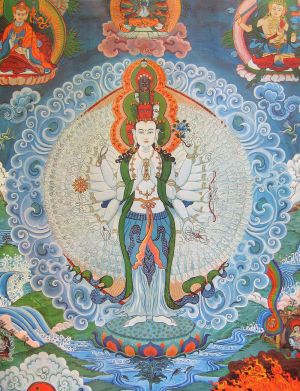Avalokiteśvara in early Tibet I: Guiding the dead
To the Tibetans, who know Avalokiteśvara as Chenrezig (Spyan ras gzigs), he is both compassion personified and the patron deity of Tibet. The popularization of Avalokiteśvara in Tibet is often linked to the figure of Atiśa, the Bengali monk who helped revive Buddhism in Tibet in the 11th century. However, our manuscripts show that by the 10th century, well before Atiśa came to Tibet, Avalokiteśvara was an important part of the Tibetan Buddhist landscape.
In the 1970s some important Tibetan Dunhuang texts on after-death states featuring Avalokiteśvara were discovered by Rolf Stein and Ariane Macdonald. The first of these was Showing the path to the land of the gods (Lha yul du lam bstan pa), which describes the various paths which the dead can follow, and encourages them to remember the name of Avalokiteśvara and to call upon him in order
to avoid the hells. The second text was identified by Stein as a funeral rite of the pre-Buddhist Tibetan religion transformed into a Buddhist practice featuring Avalokiteśvara. A third text, also concerned with death and the after-death state and called Overcoming the three poisons (Gdug gsum ’dul ba), was examined by Yoshiro Imaeda, who found that it contained Avalokiteśvara’s six-syllable mantra, oṃ maṇi padme hūṃ.
These discoveries showed that Avalokiteśvara played an important role in replacing the pre-Buddhist funeral rituals with Buddhist ones. In future installments I’ll say more about the many different forms of Avalokiteśvara which became popular, and his role in meditation practices.
References
1. Imaeda, I. 1979. “Note préliminaire sur la formule oṃ maṇi padme hūṃ dans les manuscrits tibétains de Touen-houang.” In Michel Soymié (ed.) Contributions aux études sur Touen-Houang. Geneva/Paris: Librairie Droz.
2. Macdonald, A. 1971. “Une lecture des Pelliot tibétain 1286, 1287, 1038, 1047, et 1290: Essai sur la formation et l’emploi des mythes politiques dans la religion royale de Sroṅ-bcan sgam-po.” In Études tibétaines dédiées à la mémoire de Marcelle Lalou. Paris: Libraire d’Amerique et d’Orient Adrien Maisoneuve.
3. Stein, R.A. 1970. “Un document ancien relatif aux rites funéraires des Bon-po tibétains.” Journal Asiatique CCLVII: 155–185.
